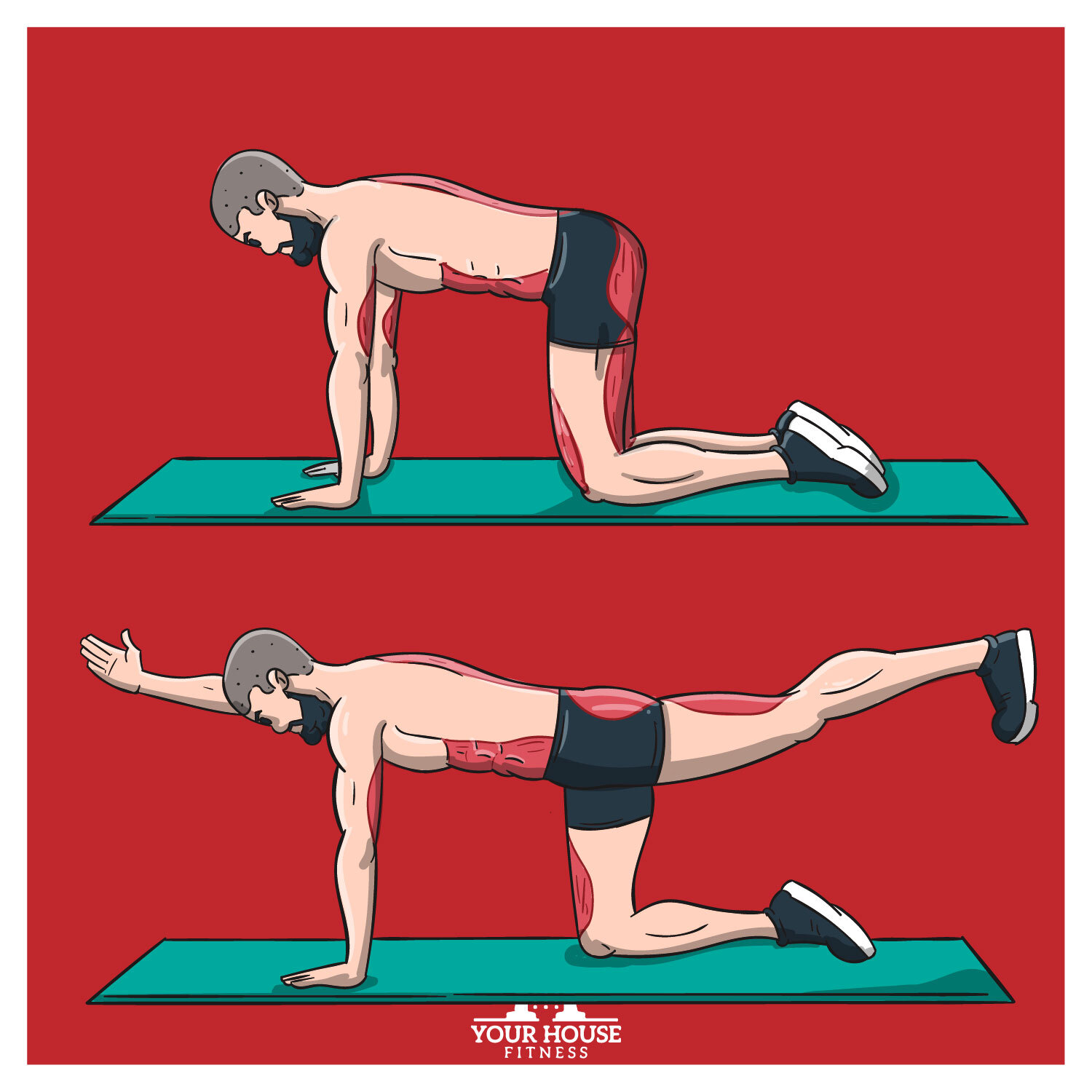Exercise Tutorial: Bird Dog
Table of Contents
What Is a Bird Dog Exercise
The Bird Dog is a simple bodyweight exercise that is used to improve core and low back strength. Once mastered, the Bird Dog can help to improve stability, range of motion, and improve strength in the back, core, glutes, and hamstrings.
Bird Dog Exercise Tutorial Video
Experiencing low back pain from sitting down all day? Then the Bird Dog is for you! The Bird Dog is a popular exercise that is often performed incorrectly! This simple bodyweight movement is great for improving low back strength and increasing stability. Watch now to learn how to execute the Bird Dog properly.
How to Do Bird Dog Exercise
Begin on your hands and knees with your palms underneath the shoulders and your knees underneath the hips.
Keep your back straight, engage your core and lift the opposite arm and leg at the same time so they are both fully extended. Avoid twisting of the torso.
Lower both limbs at the same time to return to your starting position.
Repeat this movement with your remaining arm and leg.
Bird Dog Exercise Muscles
An advantage of the Bird Dog is that this exercise engages numerous muscles. According to the Strength and Conditioning Journal.
Bird Dog Exercise Benefits
There are many benefits to performing the Bird Dog. In rehabilitation environments, the Bird Dog is often used to help relieve low back pain as this is a low-impact exercise that targets the core. As well, the Bird Dog can be used to help correct posture as it targets the Erector Spinae, an important muscle group involved in keeping the back upright and in lateral flexion.
Additional benefits of performing the Bird Dog include,
increased Core Stability
Strengthens the Lower Back
Promotes a Neutral Spine
Promotes Overall Body Awareness
Bird Dog Variations
It takes time and practice to master the Bird Dog! If raising both limbs at the same time is difficult or too easy, there are different variations that you can try.
Bird Dog Regression
Begin in the same starting position as described above. Instead of raising both limbs at the same time, only raise one arm. Return to the starting position and then only raise the opposite leg. Continue to alternate through raising only one arm and only one leg.
Bird Dog Progression
Elbow to Knee
Perform the classic Bird Dog described above. Instead of returning the raised arm and leg to the ground, have your elbow touch your knee. Then return to your starting position and repeat the movement on the opposite side.
Push Up
Begin with your hands on the ground in front of your shoulders and your legs extended behind you in a push-up stance. Lift your opposite arm and leg at the same time. Return to the starting position and repeat the movement on the other side.
Single Side
This is for the very advanced! Begin in the classic Bird Dog position. Instead of raising the opposite arm and leg at the same time, raise both your arm and leg on the same side of your body. Return to the starting position and repeat the movement on the other side of your body.
Additional progressions can include performing the classic Bird Dog with ankle and wrist weights, rotating the wrist and ankle when the limb is extended, or using a resistance band.
What Does Bird Dog Mean
The Bird Dog exercise is named after the position of a hunting dog who is pointing at its prey. When we extend our limbs, we can resemble the dogs when they are locating a bird. When we come back on all fours, we resemble a normal dog. These hunting dogs have also been referred to as Bird Dogs which contributed to this aptly named exercise.
Why Is the Bird Dog Useful
In addition to its many benefits, the Bird Dog is a useful exercise to correct and avoid injury or pain in the lower back. Whether you are sitting at a desk all day or sitting down watching TV, the number of sedentary hours is increasing which can create muscle tightness in the lower back and glutes. When muscle tightness is ignored, the incidence of muscle pain increases.
Exercises like the Bird Dog are very useful in addressing and preventing this pain from occurring. Having a daily mobility routine is a great way to practice movement hygiene and keep your muscles and joints healthy and happy!
How Should the Back Be Positioned When Performing a Bird Dog Exercise?
When performing the bird dog exercise, it's crucial to remember that its effectiveness largely depends on proper back positioning. Here are the recommendations for achieving the correct back position:
Emphasize balance: A common technique is to place a ball on your lower back to monitor its movement. Excessive movement indicates a need for improved balance and coordination.
Control the movement: Although you might shake initially, aim for slow and controlled movements. Sudden, violent movements are counterproductive.
Start with your spine: Your spine needs to be neutral and straight. Avoid any arching in your back. Imagine a line extending from your head to your tailbone and keep that line straight.
Keep your core braced: Often, people forget to engage their core properly. The goal is not to rapidly lift opposite arms and legs, but to move slowly and keep your core engaged, as if bracing for a punch in the belly. This engagement should be maintained throughout the entire movement.



